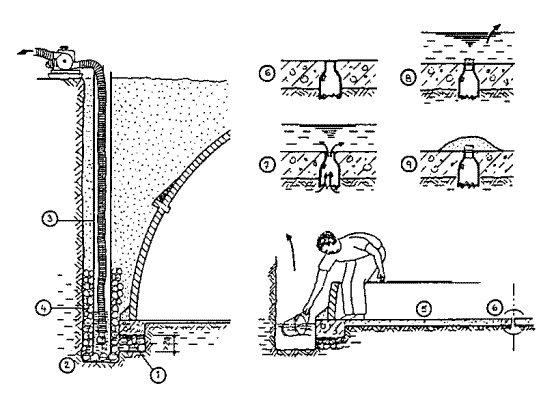Knowledge fuels change
For over a decade, Energypedia has shared free, reliable energy expertise with the world.
We’re now facing a serious funding gap.
Help keep this platform alive — your donation, big or small, truly matters!
Thank you for your support
Biogas Implementation - Groundwater Management
Overview
Underground water features in all three steps of biogas implementation:
- During planning, the site selection and design of the digester can eliminate most of the problems caused by groundwater and threats to groundwater.
- During construction, groundwater can be a nuisance, effecting additional costs. But it is during construction, that serious leakage can be avoided.
- During operation, little can be done but to monitor the quality of water and to avoid surface spilling.
Solutions
By positioning the biogas plant and the well, a great deal of drinking water safety can be achieved.
First, the distance should be at least 30 m, second, the biogas plant should be downstream of surface- and groundwater flows and third, the well should be above the biogas unit to avoid contamination through surface spilling.
During construction, ground water must be drained. An empty biogas digester can develop such buoyancy, if surrounded by water, that the whole shell is lifted. The figure below illustrates some simple techniques how to deal with ground water during construction of small biogas plants.
 Dealing with ground water during construction[1]: The foundation rests on a stone packing (1) to drain the water into the pump-sink (2). A layer of gravel prevents blockage of the drain. A vertical pipe (3) allows pumping even when back-filling has be done. The lower part of the pipe is surrounded by a stone packing (4). If the ground water is only slightly higher than the digester bottom or if no pump is available, the construction must be flooded. The floor must be of solid concrete (5). Water must be kept away until the outer wall has reached above the ground water table and has been plastered from the outside. Several bottles without bottoms are placed into the concrete (6). When scooping of water has stopped, ground water passes through the bottle and floods the floor (7). After completing the masonry work and covering the dome with soil, the bottle is closed and water might be taken off the digester bottom (8). The cap of the bottle is covered with cement mortar (9). In case of high ground water table a conical or bowl-shaped solid concrete slab is required. Dealing with ground water during construction[1]: The foundation rests on a stone packing (1) to drain the water into the pump-sink (2). A layer of gravel prevents blockage of the drain. A vertical pipe (3) allows pumping even when back-filling has be done. The lower part of the pipe is surrounded by a stone packing (4). If the ground water is only slightly higher than the digester bottom or if no pump is available, the construction must be flooded. The floor must be of solid concrete (5). Water must be kept away until the outer wall has reached above the ground water table and has been plastered from the outside. Several bottles without bottoms are placed into the concrete (6). When scooping of water has stopped, ground water passes through the bottle and floods the floor (7). After completing the masonry work and covering the dome with soil, the bottle is closed and water might be taken off the digester bottom (8). The cap of the bottle is covered with cement mortar (9). In case of high ground water table a conical or bowl-shaped solid concrete slab is required. |
During the operation of the biogas plant further attention has to be paid to keeping the groundwater clean. Seeping biogas digesters and unprotected slurry storage can pollute water sources chemically (nitrate poisoning can be fatal for infants) and biologically (mainly with toilet biogas plants). Reasons may be wrong configuration of security devices like the pressure relief valves or because of leakage in lower parts of the digester. Smaller cracks, however, close up in the course of time through particles in the slurry.
Trace metals applied to natural systems do not pose a threat to groundwater quality because trace metals are usually removed from the percolating water by adsorption or chemical precipitation within the first few meters of soil, even in rapid infiltration systems with high hydraulic-loading rates.
Bacterial removal from effluents passing through fine soils is quite complete. It may be less complete in the coarse, sandy soil used for rapid infiltration systems. Fractured rock or limestone cavities may provide a passage for bacteria that can travel several hundred meters from the point of application. This danger can be avoided by proper geological investigations during site selection.
References
- ↑ Sasse, Kellner, Kimaro: Improved Biogas Units for Developing Countries, GATE 1991



















